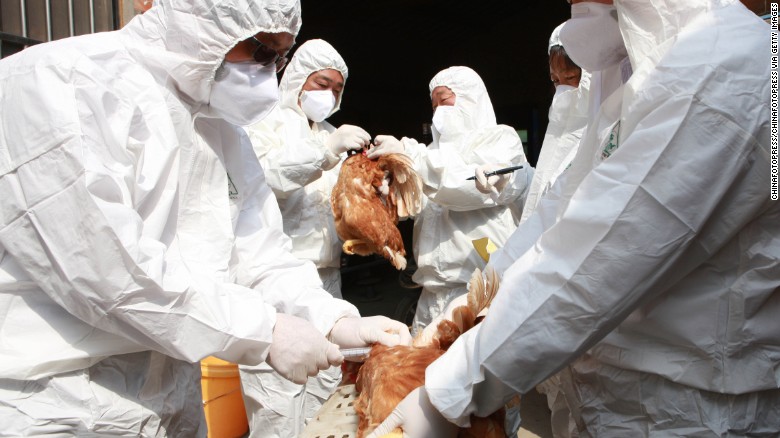A total of 460 people in China have had confirmed infections of avian influenza since October, according to the World Health Organization.
The number of people infected in China “exceed previous seasons,” said Dr. Wenqing Zhang, head of the Global Influenza Program at the WHO. They represent more than a third of the cases reported since this strain of the virus was first shown to infect humans in 2013.
The virus mainly infects birds, but certain strains, or types, have mutated to transmit from birds to humans. Some human-to-human transmission occurred but was not sustained.
Zhang concluded that the risk of human-to-human transmission with H7N9 bird flu remains low.
China is experiencing its fifth wave of human infections with the H7N9 strain of the virus since 2013.
Symptoms include fever, cough, sore throat and sometimes pneumonia and can be treated with antiviral medications.
Changes and mutations
During this transmission season, an estimated 7% of humans infected with this type of bird flu had markers linked to resistance against one of the main categories of antivirals used to treat infections, known as neuraminidase inhibitors, such as oseltamivir (Tamiflu).
Those showing signs of resistance had already been treated with antivirals, implying that the virus may have developed resistance inside their bodies, rather than because they were infected with a resistant strain.
Despite this slight increase in resistance to drugs, the WHO recommended that treatment continue as usual. “There is no evidence to recommend changes in clinical management,” Zhang said.
Dr. Mike Skinner, a virologist at Imperial College London whose research focuses on avian viruses, said that seeing resistance in people “doesn’t mean that will transit to someone else.” In fact, he added, there may even be some sort of genetic payoff in the change, leaving the virus less able to transmit.
Viruses from three recent human H7N9 cases also showed genetic changes that make them more pathogenic — or harmful — in birds.
The potential for this strain of the virus to cause severe disease in birds was previously thought to be low, acting as a reminder that viruses are constantly changing and need to be monitored, the WHO said.
But Skinner added that “these changes seen in humans might help in controlling the virus.” Infected birds will be easier to identify, as their symptoms will be more severe, helping poultry farmers and sellers identify the virus early and cull animals before it has time to spread more widely.
During earlier outbreaks, “it was hard to know whether it was in your birds,” Skinner said. “But they are beginning to see highly pathogenic viruses in the bird markets,” flagging the need to shut markets down and cull birds accordingly.
Zhang and other experts from the WHO presented the latest findings Wednesday after a surge in cases of H7N9 were reported in China and outbreaks of H5N8 continue to occur in Europe, though solely in birds.
Dr. Yuelong Shu, director of the WHO Collaborating Center for Reference and Research on Influenza at the Chinese Center for Disease Control and Prevention, said he believes the current epidemic “is past the peak already,” as the numbers of infected are coming down.
Poultry outbreaks
The family of H5 avian influenza viruses — such as H5N1 and H5N2, up to H5N9 — continues to spread among the avian population, in both poultry and wild birds, Zhang said.
Dr. Jackie Katz, director of the WHO Collaborating Centre for the Surveillance, Epidemiology and Control of Influenza at the US Centers for Disease Control and Prevention, added that more than 1,000 outbreaks among poultry have been reported to the WHO.
Birds have been infected across Europe, the Middle East, Africa and Asia since June, with sites in Europe most affected.
Cases first arrived in Europe in the Baltics and spread down from there, said Skinner, who believes that this outbreak has also begun to burn out. “It’s effectively migration-driven,” he said. “Most of the infections seen in farms here (are) driven by migrating birds.”
Outbreaks among birds will continue to occur, however, and given their recurrence, Katz highlighted that “sporadic infection of humans can occur.”
“We need to prepare for the possibility,” she said, also referring to potential changes to the viruses that may enable them to transmit into humans more efficiently.
For now, the WHO recommended precautionary measures to prevent infection, including avoiding poultry farms and contact with live birds, washing hands regularly, covering your nose and mouth when near poultry, and cooking meat thoroughly.
They concluded that risk from H5N8 and H7N9 remains low but that it is “likely further sporadic cases will continue to be reported,” Zhang said.



